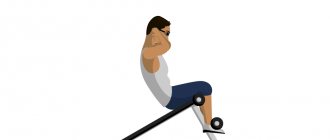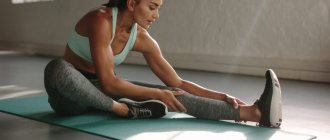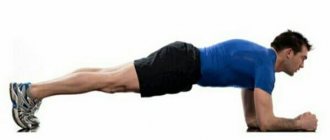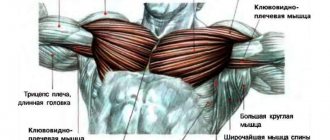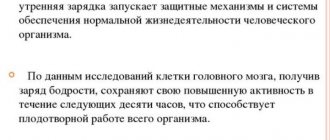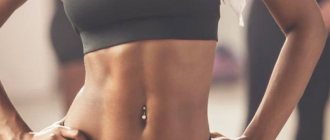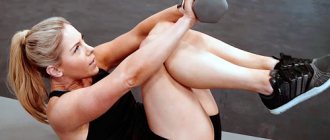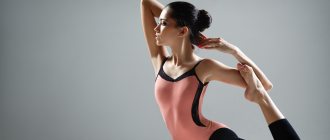How to remove belly fat after childbirth
Such a long-awaited birth of a child is truly a key moment in a woman’s life.
At this starting point, one stage of your life ends, and a new one begins, full of its own mysteries, joys and difficulties. You may notice that you have changed somewhat in appearance: in particular, your tummy is no longer as toned and firm as it was before pregnancy.
Don’t be upset, because this is a common occurrence, and it probably didn’t happen to any of the women who gave birth. In order to get back into shape, you just need to have a good rest and do everything so that your baby knows that his mother is the most beautiful.
Crunch Colbert
This workout is recommended by fitness instructor Petra Colbert, who has created a whole range of exercises available in the form of ten-minute video files.
- Step 1. Lie on your back, raise your legs, bend your knees at an angle of 90 degrees. Your ankles should be parallel to the floor.
- Step 2. Place your hands behind your head (with your elbows pointing strictly in different directions, not up) and twist, lifting your shoulders off the floor.
- Step 3: Extend your legs diagonally, cross your ankles, and extend your arms overhead. While holding this position, perform the scissoring motion with your legs eight times. Return to the starting position. Do eight reps.
How does the belly appear after childbirth?
New mothers may be surprised to notice that after giving birth, the belly is in no hurry to disappear. This is due, firstly, to the fact that during pregnancy a fairly massive layer of fat accumulates in the abdominal area, protecting the baby from mechanical damage and performing thermoregulation for him. This “strategic reserve” also has a beneficial effect on lactation during breastfeeding.
Throughout gestation, the uterus increases significantly. In order to take on its previous shape and size, it requires at least 4 weeks. Therefore, in the first month after giving birth, your tummy will most likely look as if you are still 5-6 months pregnant.
Also during pregnancy, the rectus abdominis muscles (commonly called the “pack”) tend to separate. At the same time, the white line passing between them increases. This phenomenon is called diastasis. When the linea alba is stretched, you can notice that in a normal state a depression forms along the midline of the abdomen, and when the press is tense, on the contrary, a protrusion occurs.
This happens because the enlarging uterus creates strong pressure, and also as a consequence of hormonal changes in the body. Some hormones, in particular relaxin, help weaken connective tissue, making it more elastic and stretchable. This phenomenon is not at all dangerous, and surgical intervention is not required in this case.
What's happening to the stomach?
During the last trimester, a pregnant woman gets tired of a huge, uncomfortable belly. I want to give birth as soon as possible so I can pull on skinny jeans and go for a walk with my baby. However, in the postpartum period it turns out that the stomach has not shrunk enough.
It remains approximately the same as at 4-6 months of pregnancy, and at the same time looks flabby and saggy. Often stretch marks appear on it and a dark longitudinal pigment line remains, dividing the body in half. Why is this happening?
When can you start exercising after giving birth?
The period when mommy is allowed to exercise depends only on her well-being. If you did gymnastics in the last months of pregnancy, then it is likely that light physical activity will be feasible within a week after giving birth.
If during pregnancy you were forced to interrupt sports activities, then you should start again gradually. Immediately after giving birth, physical activity is extremely important, so take time for walking.
Exercises to strengthen the abdominal muscles can be started no earlier than 1.5 months after childbirth, and for mothers who gave birth by cesarean section - no earlier than 2-2.5 months.
You need to wait until the muscles naturally return to their normal position, and only then start strengthening them. Otherwise, there is a high probability that they will strengthen, being too far from each other, and it will be much more difficult to remove the belly in the future.
Postpartum period
In order not to harm your health, you need to know when you can pump up your abs after childbirth. Gynecologists recommend waiting 6-8 weeks before starting exercise. If there are complications, the period may be extended.
During this period, the uterus takes on its pre-pregnancy appearance, bleeding stops and the mucous membranes are restored. The gynecologist will be able to make a decision about starting physical exercises after a visual examination.
Possible problems:
- Uterine bleeding may begin, which will lead to serious consequences. The load must be increased gradually so as not to create excess pressure on the walls.
- Due to weakened ligaments, female organs may drop during intense exercise. To prevent this situation, use a bandage or bandage on the stomach.
The main advice for starting physical activity is the absence of discomfort and pain. If the child is restless, then it is better to wait until a better time, because... strength must be conserved.
What is the most effective way to remove belly fat after childbirth?
Undoubtedly, every mother wants to see herself as soon as possible in the form she was in before pregnancy. But it should be understood that the process of restoring the body after such a serious test is not even a matter of several months. Also, the amount of time it takes for your body to return to its original state depends on your genetic predisposition to your body type.
With active work, you will see excellent results within a year, but you should realize that the effort spent will really be worth it. In order for the work to be of the highest quality possible, you should remember a few rules:
1 Don't follow strict diets to lose weight. As we have already found out, the main volume of the tummy is created by a layer of adipose tissue. But since we are talking about the uneven growth of fat cells, the conclusion about the first and main rule naturally suggests itself.
For nursing mothers, diets are simply contraindicated, since not only will they not help achieve the desired result, they will also harm normal lactation. It only makes sense to adjust your diet in combination with physical activity.
You should still not overuse fatty, sweet and fried foods, as well as some baked goods. The menu should be balanced, full of healthy and vitamin-rich foods.
2 Before you start exercising, be sure to wear a postpartum bandage. While mommy, for natural reasons, cannot start doing gymnastics, a special bandage will help her take the first steps towards an ideal figure. If you already wore a combination bandage in the last months of pregnancy, then you can use it after childbirth. Bandages not only tighten the stomach and support the abdominal muscles, but also reduce the load on the back and help the lower back muscles recover.
Useful tips for young mothers who want to get a beautiful tummy
If you decide to take care of your figure, which has suffered somewhat from pregnancy, then listen to these recommendations:
- To warm up your abdominal muscles, be sure to do a warm-up. It should include exercises for the head, shoulder girdle, and arms. Add cardio exercise - perform dance moves to energetic music, jump rope;
- You should not increase the load with dumbbells. This will lead to the formation of voluminous muscles, but you have a different task;
- Be sure to monitor proper breathing. Exhalation must be done while tensing the muscles;
- do not do many repetitions at once, it will be enough to perform the exercise 15-20 times. But don't stick to light loads. Constantly increase the number of approaches;
- To achieve noticeable results, exercise regularly. It is very good if you can do the exercises daily. If your baby does not give you this opportunity, then pay attention to your abs at least 3 times a week;
- start training no earlier than 1-2 hours after eating. Sit down at the table after doing the exercises an hour later;
- end the exercises with stretching.
Postpartum depression in many women is associated not only with a prolonged uncomfortable psychological feeling, but also with a physiological state. After all, there was a figure, there was a waist, the stomach did not hang. Now everything is different. But something needs to be done. What? Pump up the press. The only question is when can you pump up your abs after childbirth and how best to do it.
The main task of a woman after childbirth is to recover from childbirth and devote time to the baby. But if you care about appearance, you need to try to get your abs back to normal as quickly as possible. This is easier for those mothers who are accustomed to strength training before childbirth. They only have to make a small effort to restore their former appearance.
But is it worth pumping up the press for those who have not done this before? Let's try to figure it out.
Achieving the same results in your appearance after childbirth is not easy. Hormonal changes and the kilograms gained over the months have an effect. During childbirth, the abdominal muscles are toned and remain tense for a long time. The body is under stress, which is why the muscles react this way - either they stretch like an arrow, or they relax until they hang down along with fat deposits.
When a woman is discharged from the maternity hospital, she leaves with a saggy, flabby belly. A rare woman will be lucky enough to be left without the bonus of stretch marks and loose skin after childbirth. However, you should not be completely afraid of this prospect. This is a natural process. Muscles naturally lose elasticity and then gradually return to normal in the most natural way. All that remains is to help your body.
For this purpose, a number of exercises are used, including running, dancing, aerobics, and abs. For many activities you need to choose a time and place, while you can pump up your abs at home on a mat. With the right approach, you can provide your body with additional stress, which will bring the abdominal muscles into proper shape, and therefore improve your figure.
Basic exercises for the abdomen after childbirth
There is a set of home exercises that do not take much time to complete. But at the same time, doing them in good faith, you can achieve quite good results. It is advisable to repeat the set of exercises three times a day. If you have no physical training at all, start with two approaches.
Before each approach, warming up plays an important role. This could be light bending to the sides, favorite dances, jumping rope. It is very useful to spin the hoop before gymnastics, but not less than 15-20 minutes. How you breathe is important: during any workout, muscle tension should occur as you inhale, and relaxation should occur as you exhale.
1 Pelvic lifts. While lying down, bend your knees. Try to tense your abdominal muscles and at the same time slowly lift your pelvis. Stay in this position for 5-10 seconds, then slowly lower yourself. Do 10 of these exercises at a time.
2 Back raises. In a lying position, cross your arms over your chest. Spread your legs shoulder-width apart and fix them in a stationary position (rest your feet on the furniture or ask your partner to hold them). Raise your body slowly. Such exercises should be done no more than 10 at a time, but over time you can increase the number of approaches.
3 Twisting the body. Remain in a lying position with your knees bent. Raise your back while turning your body to the side. Maintain this position for a few seconds, and while exhaling, lower yourself to the starting position. Alternate the direction of movement. Start with 10 reps per set, increasing the number to 50.
4 Crunches with leg raises. Starting position – lying with your legs raised and bent at the knees. As you tense your abs and lift your torso, extend your legs forward. You can do from 5 (at first) to 25 such exercises.
5 "Plank". This is a rather difficult exercise for the first lessons; you should start it after getting used to the previous ones. Starting position: face the floor, leaning on your toes and arms bent at the elbows. Pull your stomach in and tighten your buttocks. Stretch, remaining in this position for 5-10 seconds. You can then stay in this position for up to a minute.
https://youtu.be/K2-1gJ8kLRQ
In two weeks
If the load does not cause discomfort, then two weeks after giving birth you can diversify the exercises by increasing the time and intensity of training. It is advisable to devote 30-40 minutes a day to classes, after ventilating the room and without distractions. The best time for training is during the baby's nap.
READ ALSO: How to remove a sagging belly after childbirth at home?
For abdominal and back muscles
The following exercise will help you stretch and relax your back muscles, which can be performed on the third day after childbirth while still in the maternity hospital. Curl up on your side and exhale, rounding your back, pressing your stomach to your spine. When inhaling air, the body relaxes and straightens. The exercise is performed without jerking, slowly.
READ ALSO: diastasis after childbirth: what to do if the rectus abdominis muscles diverge?
For the first time, 6 repetitions on each side are enough. Then the multiplicity is increased to 20 times. For greater load, you can keep your abdominal muscles tense, while your breathing remains even.
For the pelvis
Exercise improves blood circulation in the pelvic organs and promotes better blood circulation. The exercise can be performed on the floor or in bed. You need to lie on your back, bend your legs at the knees and press them together. The pelvis should be raised, with the upper back and feet becoming the fulcrum. As you inhale, the gluteal muscles are tense. Stay in this position for 3-4 seconds and lower down, relaxing.
For the pelvic floor muscles
After a natural birth, numerous nerve endings of the pelvic floor are injured. This occurs due to overstretching of the birth canal as the child passes through it. The consequence is swelling and temporary lack of sensitivity of the pelvic floor.
Depending on the presence of ruptures and the episiotomy performed during childbirth, the recovery of nerve fibers has a different period. You can work through this area as follows. During feeding, lying on the bed or even standing, you should try to strain and pull up the muscles of the vagina and anus as much as possible. You may not be able to feel the right muscles right away, but you should practice.
For the abdominals
The abs can be worked in different ways. The most suitable position for a mother who has recently given birth is lying on her back. Cross your legs and raise them, bending your knees. Try to reach your knees with your palms. Only the upper back is raised in the area of the shoulder blades, the rest of the body is pressed tightly to the floor. It’s great if you can fix this pose for 2-3 seconds. If it doesn’t work out, don’t worry, you can lower yourself and repeat 5-7 times.
Thus, all abdominal muscles are involved at once
Begin the exercise carefully, increasing the complexity by maximizing muscle grouping in the upper position and duration of fixation
How pregnancy affects the cortex
When you think of core muscles, you probably think of six-pack abs in your head. But the core muscle includes all the muscle tissue of the abdomen, thighs and buttocks. It is during pregnancy that this area is subject to maximum stress. The abdominal muscles become weak and stretched, the back muscles become shorter and the hips become unstable. And after childbirth, attempts to fit into old clothes are futile, the skin loses its elasticity and aesthetic appearance.
This does not mean that the muscles have weakened, the point is that the ability to create intra-abdominal pressure necessary to support the torso is lost. That’s why, immediately after giving birth, you need to start exercising to restore your stomach after childbirth, strengthen your abdominal muscles, remove your sides and get your body in shape.
Additional inventory
In order to restore your abdominal muscles after childbirth, no special home equipment is required.
If there is a desire to expand the range of exercises, purchase sports equipment.
Basic accessories:
- fitness ball of different diameters;
- inclined bench for the press;
- horizontal bar or wall bars;
- iron gymnastic roller;
- fitness elastic bands with effort.
Depending on the type of equipment, changes are made to the classes. This option is suitable for women who were actively involved in sports before pregnancy.
To perform standard exercises, you only need a rubberized mat. It is not cold and comfortable to train on.
https://youtu.be/c-VWD4FShbE
https://youtu.be/SprwUdW6NW4
Pelvic pain after childbirth
Why am I telling you all this? After the second birth, I increasingly began to experience pain in the pelvic region, and with any sudden body movement, especially when sneezing, urinary incontinence occurred. While jogging, I felt unbearable pain. At that time, my physical therapist recommended forward pelvic tilts, belly breathing, and belly retraction. As a result, my muscles became stronger, and the ligaments returned to their place, and most importantly, the pain gradually began to go away.
The following exercises for tightening the abdomen and sides after childbirth are aimed at strengthening and working out the muscles of the pelvic floor, transverse abdominal muscles and core. These exercises are quite simple to perform, so you can start doing them immediately after childbirth, if they were natural.
Incorporate pelvic tilts, belly breathing and belly retraction into your life when you feel comfortable after the birth of your baby. As you pull in your belly, add more arm and leg movements to prepare for more intense movements.
Secret dangers
The first obstacle on the path to a slim figure immediately after childbirth is the need to maintain breastfeeding for as long as possible. With intense exercise, the amount of breast milk can sharply decrease, and in some cases, the precious liquid completely burns out. The second danger is diastasis of the rectus abdominis muscles. This is the name for the separation of the abdominal muscles, in which heavy physical activity is extremely harmful and can even lead to damage to the spine. Only a qualified doctor can determine the presence of diastasis and adequately assess its degree and potential risks.
However, not every young mother with a child can afford to go to the doctors unless absolutely necessary, especially if there is no one to look after the baby and she has to be taken with her everywhere. As a result, many women turn a blind eye to the danger, find a random set of exercises for the abdomen after childbirth on the Internet and get down to business, ignoring muscle pain (which, by the way, may indicate a pathological process and not the success of the exercise).
What to do if your stomach just doesn’t want to go away even if you follow a diet, and you want to get back in shape as quickly as possible? Start playing sports with the simplest and most gentle exercises that will not damage the rectus abdominis muscles and will allow you to see the much-desired wasp waist in the mirror again.
Can you do deadlifts?
There is no need to lift weights during the recovery phase of the body. Technically, you can only rely on weight lifting to get back into shape, but it will take a lot of time.
The deadlift is considered an excellent core strengthening exercise. You should start with light weights and gradually increase the load so that your body can adapt. To make the process go faster, include this exercise in your main core training plan.
https://youtu.be/gcTQQNb5vgA
Still too difficult?
If you are having difficulty performing the exercises described above, it may be that your physical fitness left much to be desired even before the birth of your child. There is no point in overexerting yourself to get back into shape, especially if you are breastfeeding. Leave the more complex workouts for later and move on to the simplest ones:
- Belly breathing. Similar exercises for the abdomen after childbirth consist of deeply feeling the movements of the abdominal muscles while breathing. Allow the muscles to contract and expand as much as possible with each inhalation and exhalation. Don't forget to breathe as deeply as possible.
- Press tension. Start from the starting position: lying on the floor. Tighten your abs, squeezing your entire core as if preparing to take a punch to the stomach. From this position, perform a variety of movements, such as raising one or both arms above your head or stretching your legs. Remember that your back should be completely on the floor.
How to quickly lose belly fat after childbirth
Before learning how to get rid of excess waist size, you need to immediately learn about the types of fat found in the body. The subcutaneous fat layer that a person feels and sees does not pose any particular danger. Visceral fat, which surrounds the internal organs, is the real enemy, making the tummy look big. When there is too much of it, it pushes out subcutaneous fat, which visually increases the volume of the body.
To quickly lose belly fat after childbirth and lose weight, you should fight both types of fat, focusing on adjusting your diet and specialized physical activity (morning exercises, yoga, jumping rope, cycling). Exercises for tummy tuck should begin after 3-4 weeks. These include crunches, pelvic and back raises, squats and planks. As for nutrition, its adjustment can be made only after the end of lactation. High-calorie foods are excluded from the menu: smoked meats, sweets, baked goods and others.
What cosmetology and medicine offers
If you need to tighten your stomach very quickly, or if other methods are powerless, cosmetic and surgical techniques can come to the rescue. Neodymium lifting is popular now, which currently has no analogues. In this case, a special laser is used that stimulates collagen synthesis, thereby tightening the skin.
Other methods are lipolytic mesotherapy, ultrasound liposuction, ozone therapy, which involve either the breakdown of fat cells or their reduction in size. Non-surgical tummy tuck using threads is also popular.
If the cause of sagging abdomen is not muscle weakness, but excess adipose tissue, then liposuction can come to the rescue. A method such as nanoliposuction simultaneously helps to tighten the skin of the abdomen and remove excess fat.
If we are talking about particularly difficult cases, the abdominoplasty procedure, an abdominal plastic surgery that involves removing excess skin, can be a salvation. It can be effective after childbirth and severe weight loss. Please note that the operation is quite serious, and before deciding to undergo it, you need to take into account all the doctor’s advice and existing contraindications.
Most women want to tighten their skin after childbirth. Which procedures are indicated for this are decided individually in each case. If a woman is young and this is her first birth, a non-surgical lift in the form of plastic massage and cosmetic products will be sufficient. If there have been several births and the skin has stretched greatly, plastic surgery may be required, the price of which will be determined by its complexity.
There are a large number of ways to tighten your stomach. If you choose to deal with this problem on your own, you should not focus on tightening your stomach in a week or other short period of time. It is important to approach this issue responsibly and prepare for a long struggle.
Remove belly fat after childbirth at home
You can begin postpartum recovery a month after the baby is born. The following common exercises will help you quickly get rid of your belly after childbirth at home and get your body in order:
Press tension . This exercise for the abdomen is done while standing, sitting while swaddling a baby or washing dishes. Pull your tummy in and hold it for 20 seconds. Increase the time a little each day.
- Pelvic lift . Lie on your back, press it firmly to the floor. Bend your knees and lift your pelvis as high as possible. Hold for 20 seconds at first, gradually increasing the tension time.
- Wall squats . Stand with your back to the wall, press your shoulders. Slide smoothly down until your feet form a right angle with the floor. Walk back slowly.
- Plank . Lie face down, then support your arms, creating a right angle with the floor. Tear off your chest and waist, stretch into a string and hold for 30 seconds. Increase the fixation time each time.
Dolphin plank
Static exercises for abdominal recovery after childbirth are widely known. First of all, we are, of course, talking about the plank and its many varieties. Young mothers are offered an effective dolphin plank, which requires a gymnastic ball.
Get into a starting plank position with your elbows on the exercise ball and your legs extended. Tighten your abdominal muscles and thighs, straighten your back and hold this position for at least thirty seconds. This position can be considered a standard, classic plank, but to increase the difficulty, experts recommend using a fitball, which makes the entire pose unstable.
Vacuum
A vacuum exercise after childbirth will help you get rid of a hanging belly. To minimize the load on the internal organs and pelvic muscles, training is performed while lying down. A vacuum is created by expanding the chest. How to do a vacuum exercise for the abdomen after childbirth:
lie down on a hard surface, bend your knees;
Contractions while standing
We stand straight, legs slightly bent at the knees. Place your hands on your hips just above your knees, and transfer the weight of your torso a little onto your palms. We move the buttocks back so that the back is straight from the buttocks to the neck. Next, we sigh, and as we exhale, we draw in our stomach as much as possible. At the same time, we move our hips forward so that the tailbone “looks” at the floor. We linger in this position for five seconds, after which we slowly move our buttocks back so that the back becomes straight again. We repeat this exercise 10-12 times.
Exercises for diastasis
Diastasis abdominis is the separation of the rectus muscles relative to the linea alba. Many women encounter this medical term after pregnancy. Treatment of diastasis is carried out conservatively or surgically, depending on its severity. Special exercises for diastasis of the abdominal muscles after childbirth will help restore the discrepancy of the abdominal wall at home. Each should be performed 10 times daily:
Get on all fours, arch your back in an arc (crampon). Inhale slowly, gently drawing in your tummy. As you exhale, straighten your back.
Peculiarities
After the birth of a child, under the influence of oxytocin, the uterus contracts and the abdomen gradually decreases. This is a natural process and there is no need to interfere with it.
https://youtu.be/XtLZqhPGhs8
Women wonder how to restore their abs after childbirth.
It is a mistaken belief that you can get in shape faster with increased loads.
Of course, the muscles will get stronger, but effective complexes are needed to get rid of the accumulated fat layer. It is necessary to gradually add aerobic exercise and stretching.
Another problem is the discrepancy of the abdominal press. Diastasis appears during pregnancy and remains in women after childbirth. The reason is a large fruit or increased tissue elasticity.
You can determine the problem with self-diagnosis. To do this, you need to lie on your back, raise your head and bend your knees.
If a depression is found in the middle of the abdomen, then measures need to be taken. Exercises in a bandage and active sports will help.
If the disease is serious, you may need the help of a specialist.
https://youtu.be/eRZvwO-Zs50
Exercises for a saggy belly
Effective postpartum recovery depends on regular exercise. Work out your abs from 3 times a week to 7. Start any workout for a hanging tummy with a general warm-up without using weights, so as not to create unnecessary relief. When performing flat press movements, practice proper breathing. Start with one approach, gradually increasing the number of repetitions. A set of exercises for a sagging belly after childbirth:
While sitting on the bed, place your hands behind your head. Lower your back and pull your legs towards your chest. Slowly straighten your legs, simultaneously stretching your entire torso along the bed.
How to pump up average abs
The middle abs are those abdominal muscles that form the abdominal wall, hold and protect internal organs, and also shape human posture. It is quite difficult to pump up such muscles; you will have to spend a lot of time and effort on this. The explanation is simple: the muscles located in the middle abdominal area are especially resilient. So each of your workouts should contain a large number of exercises.
Instructions
1 Train at home if you can’t go to the gym. Here is the first exercise: first, take a lying position, clasp both hands behind your head, and be sure to bend your legs at the knees. Next, try to raise your upper body so that your elbows touch your knees every time. During the first training sessions, five to eight exercises will be enough. Increase their number only gradually, bring them to 10 or 15, and then to 30, 40 and so on. But under no circumstances should you take on too much of a load at once. Otherwise, you risk getting only a muscle strain instead of a sculpted midsection (and this is in the best case). 2 Do your workouts regularly, because it is much more effective to do a little, but every day, than to take on sixty exercises at once, not completed on time. Over time, speed up the pace of your workouts: each approach should ideally be completed in a minute. 3 Do another exercise: again take a lying position, begin to simultaneously lift both legs up so that they end up in a strictly vertical position. This technique, by the way, allows you to pump up various abdominal muscles (both lower and middle, and upper). For best results, return your legs to the starting position as slowly as possible, without rushing. Repeat the exercise approximately 8-10 times each set. Each session should include at least two or three of these approaches.
4 Lie on the floor, put your hands behind your head and clasp them together. Next, try to bend your knees and raise your back at the same moment. You should reach your knees with your elbows (you can also crosswise, that is, touch your right knee with your left elbow, then vice versa). This exercise develops, in addition to the middle abs, also the lateral muscles of the waist. Do it at least 10 times.
Nutrition issue
As proponents of a healthy lifestyle say, exercise makes up only twenty percent of success. The remaining eighty come from proper nutrition. Currently, there are several variations of the so-called PP system. Whatever you choose for yourself, you shouldn’t give up on physical exercise. To remove belly fat after childbirth, you will need to make every possible effort.
The simplest option for proper nutrition is to avoid junk food or reduce its consumption to a minimum. Products harmful to health and figure include all kinds of sweets, baked goods, processed foods, sausages, sweet carbonated drinks, chips, flavored crackers and other “snacks”. It is advisable to limit the consumption of fatty meats (pork, lamb) and replace them with beef, veal, rabbit, and poultry. Although it is believed that according to the rules of a healthy diet, you should use vegetable oil and not butter or margarine for frying, in fact, PP does not accept frying in oil at all. You can cook your favorite pancakes, pancakes and chops, but only in a dry frying pan with a good non-stick coating. Meat is good to grill.
A complicated version of PP is a kind of diet that enhances the effect that exercises give after childbirth for the abdomen, sides and hips. According to her rules, you need to eat 5-6 times a day in small portions (200-300 g each). For breakfast, eat protein foods and cereals rich in complex carbohydrates; for second breakfast - healthy fats (for example, nuts) and carbohydrates. At lunchtime, it is advisable to combine proteins, complex carbohydrates and vegetables at once (this can be meat and fish dishes with a side dish in the form of pasta or potatoes and vegetable salad). For an afternoon snack they eat vegetables and protein products (preferably fermented milk), for dinner - again proteins and vegetables. At night you need to drink a glass of kefir or eat a little cottage cheese, since even during sleep the body does not stop functioning and needs nourishment. If during the day you performed intense exercises for the abdomen after childbirth, it is better to prefer cottage cheese to kefir - it contains more animal protein, which is useful for muscle development.
If you're serious about exercising, you might be interested in sports nutrition. First of all, fitness enthusiasts pay attention to protein. Highly nutritious shakes and protein bars are rich in easily broken down protein - they help strengthen muscles and increase the overall effectiveness of strength training.
Push ups
Push-ups simultaneously train the muscles of the arms, shoulders, chest and abs.
- Step 1. Take the starting position, resting your palms and toes on the floor. The distance between the palms should be slightly wider than the width of the shoulders.
- Step 2: Bend your elbows and lower your chest until there is about a couple of centimeters between your chest and the floor.
- Step 3. Straighten your arms and rise to the starting position.
- Step 4: Perform 1-3 sets of 10-20 reps.
Crunches with a towel
It is quite possible that among dozens of twist variations, this particular version will seem most suitable to you. If you are sooner or later disappointed by the relative ease of the proposed exercise, modified and complicated versions of twisting will help tighten your stomach after childbirth.
- Step 1: Lie on your back with your knees bent. Squeeze the opposite ends of a medium-length towel with your hands and drape it over the tops of your shins. Pull the ends of the towel and squeeze your thighs.
- Step 2: Take a deep breath, then exhale and draw your stomach in, lifting your shoulders off the floor. Hold this position.
- Step 3. Tighten and relax your abdominal muscles 10 to 12 times, gradually increasing this number to 20 repetitions.


